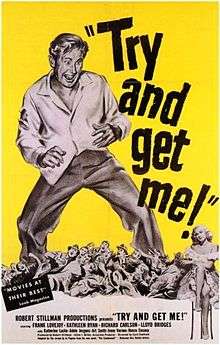The Sound of Fury (film)
| The Sound of Fury | |
|---|---|
 Theatrical release poster | |
| Directed by | Cy Endfield |
| Produced by | Robert Stillman |
| Screenplay by | Jo Pagano |
| Based on |
the novel The Condemned by Jo Pagano |
| Starring |
Frank Lovejoy Kathleen Ryan Richard Carlson |
| Music by | Hugo Friedhofer |
| Cinematography | Guy Roe |
| Edited by | George Amy |
Production company |
Robert Stillman Productions |
| Distributed by | United Artists |
Release date |
|
Running time | 92 minutes |
| Country | United States |
| Language | English |
The Sound of Fury (reissued as Try and Get Me) is a 1950 crime film noir directed by Cy Endfield starring Frank Lovejoy, Kathleen Ryan, and Richard Carlson.[1] The film is based the 1947 novel The Condemned by Jo Pagano, who also wrote the screenplay.[2]
The film is based on events that occurred in 1933, when two men were arrested in San Jose, California, for the kidnap and murder of Brooke Hart. The suspects confessed and were lynched by a mob of locals. The 1936 film Fury, directed by Fritz Lang, was inspired by the same incident.
Plot
Howard Tyler (Frank Lovejoy) is a family man, living in California, who can't seem to get by financially. He meets up with a small-time, but charismatic, hood Jerry Slocum (Lloyd Bridges). Soon, Slocum convinces Tyler to participate in gas station robberies to get by. Later, they kidnap a wealthy man in hopes of getting a huge ransom. Things go wrong when the man is murdered by Slocum then thrown in a lake. Tyler reaches his limit emotionally, and he begins drinking heavily. He meets a lonely woman and confesses the crime while drunk. The woman flees and goes to the police.
When the two kidnappers are arrested, a local journalist (Richard Carlson) writes a series of hate-filled articles about the two prisoners which eventually lead to a brutal lynching.
Cast
- Frank Lovejoy as Howard Tyler
- Kathleen Ryan as Judy Tyler
- Richard Carlson as Gil Stanton
- Lloyd Bridges as Jerry Slocum
- Katherine Locke as Hazel Weatherwax
- Adele Jergens as Velma
- Art Smith as Hal Clendenning
- Renzo Cesana as Dr. Simone
- Irene Vernon as Helen Stanton
- Cliff Clark as Sheriff Deming
- Harry Shannon as Mr. Yaeger
- Donald Smelick as Tommy Tyler
Reception
Critical response
The New York Times film critic, Bosley Crowther, panned the film, writing "Although Mr. Endfield has directed the violent climatic scenes with a great deal of sharp visualization of mass hysteria and heat, conveying a grim impression of the nastiness of a mob, he has filmed the rest of the picture in a conventional melodramatic style. Neither the script nor the numerous performances are of a distinctive quality."[3]
Raymond Borde and Etienne Chaumeton, in a work on American film noir, wrote that "the prison assault remains one of the most brutal sequences in postwar American cinema."[4]
Film critic Dennis Schwartz liked the film and discussed the political and social aspects of the film. He wrote, "Endfield's social consciousness film hits hard at uncontrolled violence in small-town America in much the same way as did Fritz Lang's Fury (also based on the same factual episode). Soon after making this film, the director was blacklisted because of his leftist positions on social and political issues. It's a superb characterization of America's thirst for crime and violence; one of the most powerful statements ever from a Hollywood film about the class divide in America and the yellow rag press that incites the public with poisonous newspaper coverage to sell papers. It calls attention to something about the 'cowboy attitude' in Americans that they don't like to acknowledge about themselves, but Europeans are quite aware of how uncivilized Americans can be."[5]
Accolades
Nominations
- British Academy of Film and Television Arts Awards: Best Film from any Source; 1952.
References
- ↑ "The 100 Best Film Noirs of All Time". Paste. August 9, 2015. Retrieved August 9, 2015.
- ↑ The Sound of Fury at the American Film Institute Catalog.
- ↑ Crowther, Bosley. The New York Times, film review. Accessed: August 19, 2013.
- ↑ Borde, Raymond and Etienne Chaumeton. A Panorama of American Film Noir 1941-1953. 1955. ISBN 0-87286-412-X.
- ↑ Schwartz, Dennis. Ozus' World Movie Reviews, film review, December 6, 2004. Accessed: August 19. 20134.
External links
- The Sound of Fury at the American Film Institute Catalog
- The Sound of Fury on IMDb
- Try and Get Me at AllMovie
- The Sound of Fury at Film Noir of the Week by Glenn Erickson